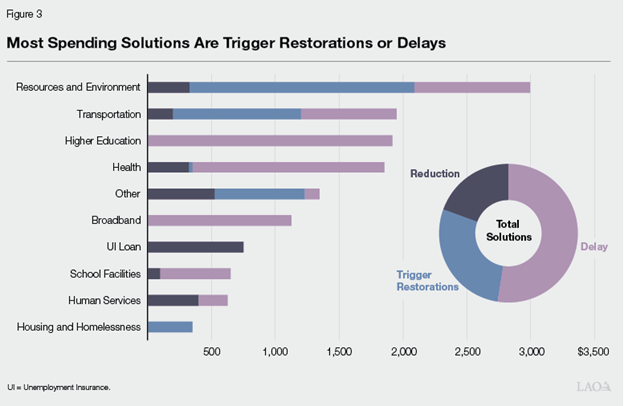ITUP Blog: Governor’s Fiscal Year 2023-24 Budget Proposal
By Mary Nguyen and Marissa Montano
Governor’s Fiscal Year 2023-24 Budget Proposal
On January 10, 2023, Governor Gavin Newsom released his Fiscal Year (FY) 2023-24 Budget proposal of $297 billion total funds (TF) ($223.6 billion General Funds (GF)). Health and Human Services makes up a large portion of the budget with proposed expenditures of $230.5 billion TF ($71.5 billion GF and $159.0 billion other funds (OF)).
After several years of historic budget surpluses and strong revenue growth in California, it is estimated that revenues will be significantly lower for FY 2023-24. The proposed budget assumes that the state will face a $22.5 billion budget deficit (also referred to as a budget shortfall). The Legislative Analyst Office (LAO) projects this shortfall to be lower than the Department of Finance (DOF) estimates, projecting an $18 billion budget problem. Projected budget shortfalls, which will be updated in the May Revision, result in reductions and deferments in planned spending—including various health and human services initiatives, and programs including investments in workforce, digital equity, and public health initiatives. The chart below, from the LAO, shows that most of the health-related spending solutions are delays or deferments in spending.

Following the key budget highlights summary, we discuss what to expect during the months between now and the May Revision, when the Governor will release a revised budget before it is ultimately signed into law this upcoming July. We also include resources on budget change proposals, trailer bill language, department-specific budget highlights, and more.
Key FY 2023 – 24 Proposed Budget Highlights
1. Coverage and Access Proposals
This blog selectively highlights key health and human services proposals in the FY 2023-24 proposed budget. The highlighted proposals are those that build upon California’s commitment to creating an equitable, accessible health care delivery system and addressing the social determinants of health.
Since the federal Public Health Emergency (PHE) has been extended until May 11, 2023, the proposed budget assumes continued enhanced federal funding through FY 2022-23. In the May Revision, the impacts of Medi-Cal eligibility redeterminations and the gradual ending of enhanced PHE funding will be reflected.
Medi-Cal Fiscal Outlook: The state’s Medicaid program, Medi-Cal, is administered by the Department of Health Care Services (DHCS). The FY 2023-2024 proposed budget includes $137.7 billion ($32.3 billion GF) in FY 2022-23 and $138.9 billion ($38.7 billion GF) in FY 2023-24 for the Medi-Cal program, which is anticipated to provide coverage to approximately 15.2 million Californians in 2022-23 and 14.4 million in 2023-24. [i]
Managed Care Organization (MCO) Tax: The budget proposes a three-year renewal of the MCO Tax effective January 1, 2024, through December 31, 2026, to draw down at least $6.5 billion in funding support for the Medi-Cal program through FY 2026-27 ($$316.5 million FY 2023-24 and about $2 billion annually in FY 2024-25 and the following two years). This renewal follows the structure from the prior MCO Tax enacted in AB 115 (Chapter 348, Statutes of 2019) with minor changes that include updates to the base enrollment period and adjustments for enrollment changes to managed care plans effective January 1, 2024. [i][ii]
Universal Coverage: Expansion of Medi-Cal to All Adults Regardless of Immigration Status: The proposed budget maintains $844.5 million ($635.3 million GF) in FY 2023-24, $2.1 billion ($1.6 billion GF) in FY 2024-25, and approximately $2.5 billion ($2 billion GF) ongoing for investments in the Medi-Cal program. With these investments, the budget prioritizes the expansion of full-scope Medi-Cal to all income-eligible adults ages 26 to 49 regardless of immigration status on January 1, 2024. It is estimated that over 1 million undocumented immigrants will have full‑scope Medi‑Cal coverage with this expansion. [i] [ii] For more information on the uninsured in California, see a recently released report from the UC Berkeley Labor Center on coverage projections into 2024.
Covered California Health Care Affordability Reserves (HCARF): During the pandemic, the federal government provided health care marketplace subsidies for individuals and families making up to 600% of the federal poverty level (FPL)—subsidies that were previously funded by the state GF. Because of the federal subsidies, the GF dollars slated for these subsidies were put into reserve funds, and the FY 2022-23 budget included a contingency to protect this funding if the federal subsidies were not extended. Since the federal subsidies have been extended through 2025, the FY 2023-24 budget proposes temporarily transferring $333.4 million HCARF funds to the GF. COVID-19 era federal subsidies are scheduled to end in FY 2025-26, the HCARF funds will be returned after federal subsidies end to ensure that state-only premium subsidies are available in the future. [i]
Home and Community-Based Services (HCBS) Spending Plan: The proposed budget reduces the HCBS plan funding by $60 million from the Budget Act of 2022 to $2.8 billion. This proposal assumes all HCBS funding will be used by March 2024 and will not use the additional optional year to spend the enhanced federal funding. [i]
2. Delivery System Transformation
California Advancing and Innovating Medi-Cal (CalAIM): The budget proposal maintains $10 billion total funds commitment to continue transforming the health care delivery system through California Advancing and Innovating Medi-Cal (CalAIM). [i]
CalAIM Transitional Rent Waiver Amendment: The budget proposes $17.9 million ($6.3 million GF) in FY 2025-26 increasing to $116.6 million ($40.8 million GF) at full implementation for six months of rent or temporary housing to eligible individuals experiencing homelessness or at risk of homelessness. This includes individuals that are transitioning out of institutional levels of care, a correctional facility, or the foster care system and who are at risk of inpatient hospitalization or emergency department visits. [i][ii]
Behavioral Health Payment Reform: The proposed budget includes one-time, initial funding of $375 million GF in FY 2023-24 for the non-federal share of behavioral health-related services at the start of CalAIM Behavioral Health Payment Reform to mitigate cash flow issues for counties. [ii]
CalAIM Justice Involved Pre-Release Program: The proposed budget includes an estimated $109.7 million total fund ($39.1 million GF) in FY 2023-24 for the CalAIM inmate pre-release program. DHCS has begun implementing pre-release Medi-Cal eligibility and enrollment as of January 1, 2023, and is awarding $151 million in Providing Access and Transforming Health (PATH) funds to support correctional agencies to coordinate with county social services to support pre-release programs. [ii]
Health Care Workforce Investments: In the 2022 Budget Act, $1.5 billion GF was committed to supporting the health care workforce. The proposed budget defers $68 million in FY 2022-23 and $329.4 million in FY 2023-24 for health care workforce programs administered by the Department of Health Care Access and Information (HCAI). In FY 2024-25 and FY 2025-26, the other $198.7 million in funds will be allocated.
Mello-Granlund Older Californians Act Modernization Pilot Program: The proposed budget includes $37.2 million annually across five years starting in FY 2022-23 for pilot programs supporting older adult programs such as community-based services programs, senior nutrition support, family and caregiver supports, senior volunteer development, and/or aging in place. While this budget proposal is spread over five years, in the Budget Act of 2022, this investment included $186 million GF that was allocated over three years.[i] For more information on the Master Plan of Aging and CalAIM initiatives that improve care delivery and address social drivers of health for California’s older adult and dual eligible populations, see ITUP’s “Transformation and Innovation: Advancing Health for California’s Older Adults” fact sheet.
California’s Behavioral Health Community-Based Continuum Demonstration: The budget proposes $6.1 billion ($314 million GF, $175 million Mental Health Services Fund, $2.1 billion Medi-Cal County Behavioral Health Fund, and $3.5 billion federal funds) over the next five years for the Department of Health Care Services and the Department of Social Services to implement the Behavioral Health Community-Based Continuum Demonstration through the proposed Medicaid Section 1115 demonstration, effective January 1, 2024. [i][iii] To learn more about the Behavioral Health Community-Based Continuum Demonstration visit DHCS’s website.
Behavioral Health Continuum for Children and Youth: The proposed budget maintains $8 billion in total funds to build upon the continuum of behavioral health treatment and infrastructure capacity for providing behavioral health services to children and youth. [i]
Community Assistance, Recovery & Empowerment (CARE) Act: The proposed budget includes $16.5 million GF in FY 2023-24, $66.5 million GF in FY 2024-25, $108.5 million in FY 2025-26 to support county behavioral health department costs for the CARE Act (Chapter 319, Statutes of 2022). Cohort I counties will start implementation of the CARE program beginning October 2023 and Cohort II counties beginning December 2024. [ii]
3. The Future of Health: Proposals to Advance Health Equity and Address the Social Determinants of Health
California Food Assistance Program (CFAP) Expansion Timing: The proposed budget delays timing of the CFAP expansion to all income-eligible noncitizens 55 years of age or older to January 1, 2027. This is consistent with the completion of the California Statewide Automated Welfare System migration. [i]
Impacts on Historic Broadband Investment: Last Mile Deferment: The proposed budget defers $550 million in California Public Utilities Commission (CPUC) funding for last-mile infrastructure grants in FY 2023-24 to future years ($200 million in FY 2024-25, $200 million in FY 2025-26, and $150 million in FY 2026-27). [i]
The Federal Funding Account, established by the CPUC according to Senate Bill 156, will fund last mile broadband infrastructure projects to connect unserved and underserved Californians with high-speed broadband service. The Federal Funding Account has a $2 billion budget made up of state and federal funds. Projects built using the federal American Rescue Plan Act funds must be built by 2027. [iv]
Public Health Climate and Health Resilience Planning: The proposed budget includes a $25 million GF reduction in 2022-23 for Climate and Health Resilience Planning Grants. If there is sufficient GF in January 2024, this reduction will be restored. [i].
Key Government Resources
Below, we’ve provided key places to find both summary-level and detailed information on the state budget, as well as links to budget bill language (BBL), trailer bill language (TBL), and budget change proposals (BCPs).
A. Governor’s Budget/Department of Finance (DOF): This is the official page for the Governor’s Budget, which includes both detailed fiscal information (“budget detail”) and summary level information (also known as “summary” or “A Pages”), and is updated at the January Budget Release, May Revision, and upon signature of the Final Budget Act; you can also find past budgets here.
B. Administration/DOF Health and Human Services Budget Summary: This is the summary of the Health and Human Services programs in the budget. There are also summary charts for the entire budget, as well as some topic-specific summary chapters, such as Homelessness and Labor and Workforce Development, that may be tangentially related to Health and Human Services. Note: there is much more detail in individual departments’ budgets, see the links provided below, than is summarized here.
C. Department-Specific Highlights: Some departments release a “highlights” document that delves further into their department-specific budget proposals and changes.
a. Department of Health Care Services (DHCS) Budget Highlights
b. California Department of Public Health (CDPH) Budget Highlights
c. California Department of Social Services (CDSS) Local Assistance Summary Highlights
D. Proposed Trailer Bill Language (TBL)
E. Proposed Budget Change Proposals (BCPs)
Legislative Resources:
A. Legislative Analyst’s Office (LAO) 2023-24 Budget: California’s Fiscal Outlook
B. Assembly Committee on Budget
a. Highlights of the Governor’s Proposed Budget 2023-24
b. Subcommittee #1 on Health and Human Services
C. Senate Committee on Budget and Fiscal Review
a. Summary of Governor’s Proposed Budget 2023-2024
b. Subcommittee #3 on Health and Human Services
D. Proposed Budget Bill Language (BBL): TBD
Stay tuned for our next update at the May Revision!
[i] Department of Finance (DOF), Governor’s Proposed Budget Summary FY 2023-24, January 2023.
[ii] Department of Health Care Services, FY 2023-24 DHCS Budget Highlights, January 2023.
[iii] California Pan-Ethnic Health Network, State Budget Update, January 2023.
[iv] California Public Utilities Commission, Last Mile Federal Funding Account, January 2023.





